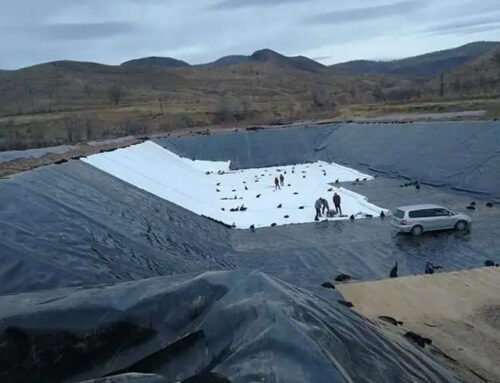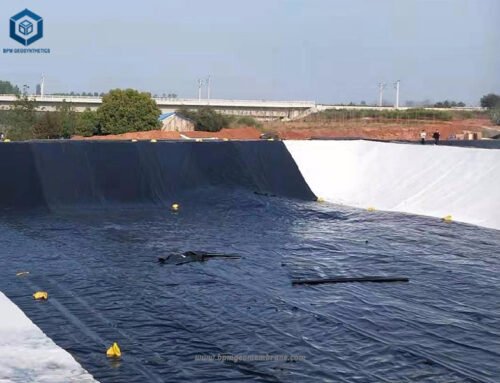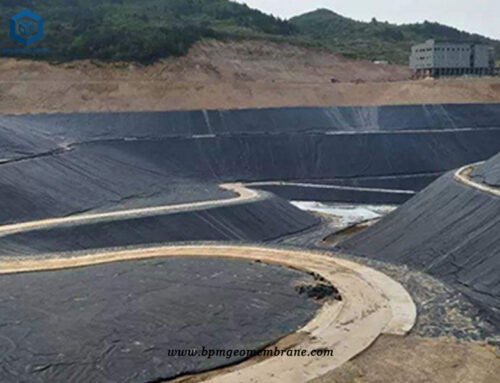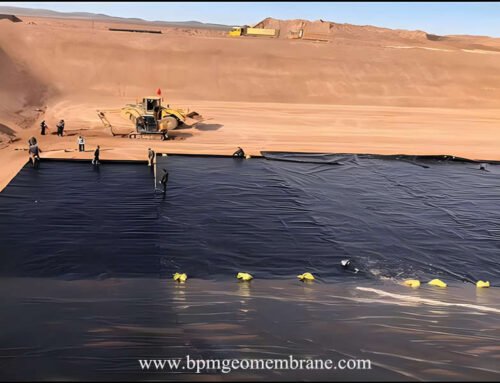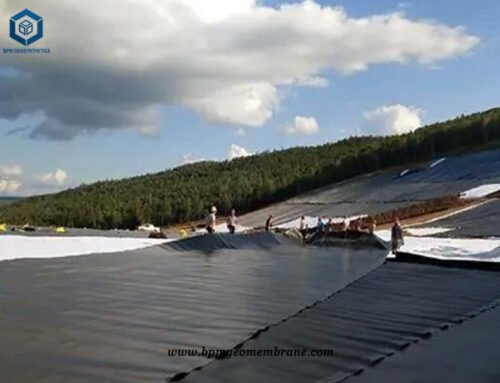LLDPE liner, also known as LLDPE geomembrane liner, is a type of geomembrane liner used for foundation, soil, rock earth or any other geotechnical engineering material as an integral part of a man made project, structure, or system. Compared with HDPE liner, LLDPE liner features good flexibility and outstanding resistance to low temperature and ultraviolet exposure, it is ideal for exposed applications like fishor shripm farm project.
BPM LLDPE liners are available in thicknesses ranging from 20 to 120 mils and offer both smooth and textured options.
1. What Is LLDPE liner?
Superior Material & Manufacturing Excellence
LLDPE liners are engineered from 100% virgin polyethylene resin, fortified with carbon black, UV stabilizers, and anti-aging additives for unmatched durability. Produced via advanced three-layer pressing technology, these liners offer consistent thickness (0.5mm–3.0mm) and come in smooth or textured finishes. Compliant with GB, GRI, and ASTM standards, they guarantee reliability for critical containment projects.
Unmatched Performance for Waterproofing Applications
LLDPE geomembranes excel in seepage prevention across diverse environments:
-
Landfills & Waste Containment – Chemical resistance blocks leachate migration.
-
Aquaculture & Irrigation Ponds – Safe for fish and crops, with UV stability for outdoor use.
- Canals & Dams – Flexible yet tough, adapting to ground movements without cracking.
Their low-temperature flexibility and near-zero permeability make them ideal for extreme climates.
Why Choose LLDPE Liners?
- Easiest Installation – Superior flexibility reduces cutting and minimizes punctures during deployment.
- Long-Term Value – 20+ year lifespan with minimal maintenance.
- Eco-Safe – Non-toxic material for potable water and sensitive ecosystems.
- Custom Solutions – Tailored thickness and textures for project-specific needs.
2. What Are The Benefits of LLDPE Liner for Ecology Pond Project?
LLDPE liner for an ecology pond project offers benefits such as chemical resistance, flexibility, elongation capacity, stress crack resistance, UV stability, easy installation, and welding capability. These advantages contribute to the effectiveness and longevity of the liner in maintaining the integrity of the ecology pond and preventing seepage.
2.1 Chemical Resistance
LLDPE liners are highly resistant to chemicals, including those typically found in ecology ponds such as fertilizers, pesticides, and organic matter. This resistance ensures that the liner remains intact and effective in preventing seepage and contamination.
2.2 Flexibility
LLDPE liners are inherently flexible, allowing them to conform to the irregular shape and contours of an ecology pond. This flexibility enables easy installation without the risk of damaging the liner’s integrity. It also facilitates adaptability to any settling or ground movement that may occur over time.
2.3 Elongation Capacity and Stress Crack Resistance
LLDPE liners have excellent elongation capacity, meaning they can stretch without tearing or developing stress cracks. This characteristic is beneficial in ecology ponds where there may be fluctuations in water levels or ground movement. The liner can accommodate these changes without compromising its effectiveness.
2.4 UV Stability
LLDPE liners have excellent UV stability, enabling them to withstand prolonged exposure to sunlight without degradation. This feature is crucial in ecology ponds where the liner is exposed to direct sunlight. It ensures that the liner maintains its integrity and performance over an extended period.
2.5 Welding Capability
LLDPE liners can be easily welded, providing secure seam connections that ensure a watertight seal. This welding capability simplifies the installation process and enhances the liner’s overall integrity. It also distinguishes LLDPE liners from HDPE liners, as LLDPE liners offer greater ease of welding.
2.6 Easy Installation
LLDPE liners are easy to install, thanks to their flexibility and the option of larger custom prefabricated panels. The panels can be tailored to fit the dimensions of your ecology pond, allowing for quicker and more efficient deployment. The simplicity of installation reduces the need for cutting, saving time and effort during the installation process.
2.7 Customizable Thickness
LLDPE liners are available in various thickness options, allowing you to choose the appropriate gauge based on the specific requirements of your ecology pond project. The range of thicknesses available ensures that the liner provides the desired level of durability and protection against seepage.
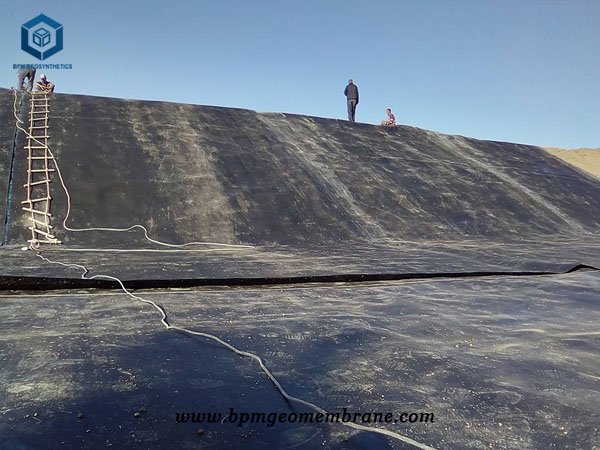
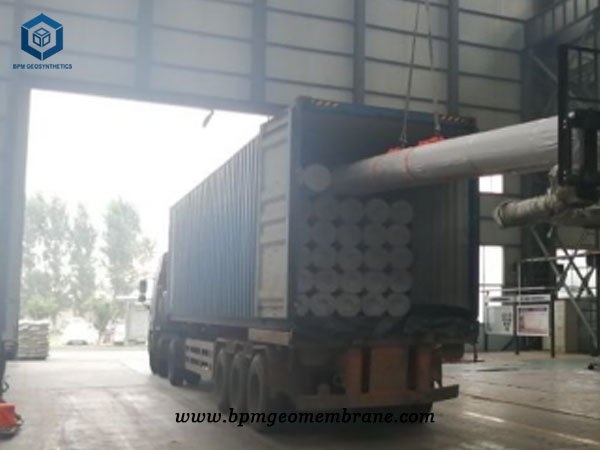
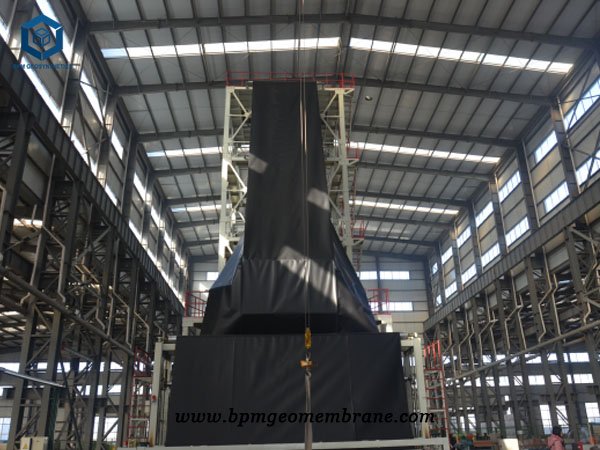
3. What Is Difference Between HDPE and LLDPE Liner?
The difference between HDPE (High-Density Polyethylene) and LLDPE (Linear Low-Density Polyethylene) liners lies in their flexibility and behavior when folded or bent.
HDPE
HDPE liners are known for their stiffness and high modulus of elasticity. When an HDPE liner is folded over upon itself, the material will be stretched beyond its yield point. This excessive stretching can result in damage and weakening of the material at that point. Due to its stiffness, HDPE liners are less flexible and have limited ability to withstand folding or bending without compromising their integrity. Therefore, HDPE liners are typically not suitable for applications that require significant flexibility or where frequent folding or bending is necessary.
LLDPE
When LLDPE is folded over on itself, the material does not undergo significant stretching or damage. LLDPE liners exhibit greater flexibility and resilience, allowing them to be folded, bent, and manipulated without compromising their performance. This flexibility gives LLDPE liners the advantage of being more easily shop fabricated. They can be conveniently shaped, cut, and assembled to fit specific project requirements, making them suitable for applications that demand adaptability to irregular surfaces and complex geometries.
Furthermore, the flexibility of LLDPE liners extends to their ability to accommodate ground movement or settlement. Their inherent flexibility enables them to withstand bending without damaging their integrity, making them suitable for projects where differential settlement or ground movement is anticipated.
Summary
In summary, the primary difference between HDPE and LLDPE liners lies in their flexibility and response to folding or bending. HDPE liners are stiffer and more prone to damage when folded, while LLDPE liners are highly flexible and resilient. The flexibility of LLDPE liners allows for shop fabrication and easier adaptation to irregular surfaces, making them a preferred choice for applications that require flexibility, maneuverability, and the ability to withstand bending without compromising their integrity.
4. Case Study of LLDPE Liner for Ecology Pond Project in Indonesia
Customer Inquiry and Product Recommendation
BPM received a request from an Indonesian customer working on an ecology pond project. The customer needed a durable geomembrane liner with an extended lifespan. As an experienced manufacturer, BPM recommended a 0.5mm LLDPE liner, known for its 50+ year service life. To validate the product’s quality, BPM sent a 12-square-meter sample along with certifications, production videos, and case studies for review.
Sample Approval and Technical Support
After testing the LLDPE liner sample, the customer approved its performance and shared their pond design for installation advice. BPM responded with detailed installation guidelines and a step-by-step video tutorial. To ensure proper seam sealing, BPM also advised using a welding machine for secure, leak-proof joints.
Project Completion and Customer Satisfaction
Through sample validation, documentation, and installation support, BPM helped the customer move forward with their ecology pond project. This collaboration demonstrates BPM’s dedication to delivering high-quality LLDPE liners and exceptional service, ensuring successful project outcomes for clients worldwide.
5. Specifications of LLDPE Liner for Ecology Pond Project in Indonesia
For the ecology pond project in Indonesia, the specifications of the LLDPE geomembrane liner are as follows:
5.1 Total LLDPE Geomembrane Liner Quantity
The project requires a total of 16,750 square meters of LLDPE geomembrane liner. This quantity is based on the specific size and dimensions of the pond.
5.2 Pond Liner Thickness
The chosen thickness for the LLDPE geomembrane liner is 0.5 mm. This thickness provides sufficient durability and protection against seepage for the ecology pond.
5.3 Roll Size
Each roll of the LLDPE geomembrane liner measures 6 meters in width and 30 meters in length. These dimensions allow for convenient handling and installation of the liner.
BPM LLDPE geomembrane liner can effectively meet the requirements of the ecology pond project in Indonesia. The liner’s thickness and roll size are chosen to ensure proper coverage, durability, and ease of installation for maximum performance and longevity.
6. About BPM Geomembrane
As the the professional geomembrane manufacturer and supplier, BPM has been dedicated to supplying one stop geomembranes and services to worldwide customers since its foundation in 2010. Our main innovative, high quality geosynthetics products include geomembranes, geotextiles, geocells, geosynthetic clay liners (GCLs), drainage boards, geogrids, etc. All BPM brand HDPE geomembranes have passed the certificates of the ISO9001, ISO14001, TUV, Soncap, SASO, BV certificates and the test of SGS and Intertek etc. Our geomembrane products have been exported to over 36 countries. If you have any questions or inquiries, please contact us.

